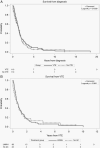Management of venous thromboembolism in high-grade glioma: Does low molecular weight heparin increase intracranial bleeding risk?
- PMID: 34383073
- PMCID: PMC8917403
- DOI: 10.1093/neuonc/noab198
Management of venous thromboembolism in high-grade glioma: Does low molecular weight heparin increase intracranial bleeding risk?
Abstract
Background: Venous thromboembolism (VTE) occurs in up to 30% of patients with high-grade glioma (HGG). Concern for increased risk of intracranial hemorrhage (ICH) with therapeutic anticoagulation (AC) complicates VTE treatment. Some retrospective studies have reported an increased risk of ICH associated with therapeutic AC; however, effective alternatives to AC are lacking. The aim of our study is to assess the risk of ICH in HGG patients with VTE on low molecular weight heparin (LMWH).
Methods: We performed a retrospective matched cohort study of HGG patients from January 2005 to August 2016. Blinded review of neuroimaging for ICH was performed. For analysis of the primary endpoint, estimates of cumulative incidence (CI) of ICH were calculated using competing risk analysis with death as competing risk; significance testing was performed using the Gray's test. Median survival was estimated using the Kaplan-Meier method.
Results: Two hundred twenty patients were included, 88 (40%) with VTE treated with LMWH, 22 (10%) with VTE, not on AC, and 110 (50%) without VTE. A total of 43 measurable ICH was recorded: 19 (26%) in LMWH, 3 (14%) in VTE not on AC, and 21 (19%) in non-VTE cohort. No significant difference was observed in the 1-year CI of ICH in the LMWH cohort and non-AC with VTE group (17% vs 9%; Gray's test, P = .36). Among patients without VTE, the 1-year CI of ICH was 13%. Median survival was similar among all 3 cohorts.
Conclusions: Our data suggest that therapeutic LMWH is not associated with substantially increased risk of ICH in HGG patients.
Keywords: glioblastoma; high-grade glioma; intracranial hemorrhage; low molecular weight heparin; venous thromboembolism.
© The Author(s) 2021. Published by Oxford University Press on behalf of the Society for Neuro-Oncology. All rights reserved. For permissions, please e-mail: journals.permissions@oup.com.
Figures


Comment in
-
Treat the VTE and worry less about the hemorrhage: A sigh of relief or is the jury still out for therapeutic anticoagulation in high-grade glioma?Neuro Oncol. 2022 Mar 12;24(3):465-466. doi: 10.1093/neuonc/noab277. Neuro Oncol. 2022. PMID: 34850168 Free PMC article. No abstract available.
References
-
- Semrad TJ, O’Donnell R, Wun T, et al. . Epidemiology of venous thromboembolism in 9489 patients with malignant glioma. J Neurosurg. 2007;106(4):601–608. - PubMed
-
- Levin JM, Schiff D, Loeffler JS, Fine HA, Black PM, Wen PY. Complications of therapy for venous thromboembolic disease in patients with brain tumors. Neurology. 1993;43(6):1111–1114. - PubMed

